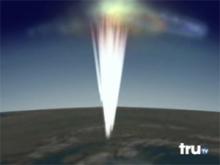A friend recently recommended a great show to me, "Jesse Ventura's Conspiracy Theory." It features all the bombast of MonsterQuest, combined with the crazy-ass topics of Coast to Coast. Add in Jesse Ventura's emphatic personal style, and you have yourself a winner.
The first episode of "Conspiracy Theory" focuses on HAARP, the High Frequency Active Auroral Research Project. HAARP has been a particular darling of the conspiracy theory set ever since 1995's (self-)publication of "Angels Don't Play This HAARP" by Dr. Nick Begich.
Begich, who has a Doctorate in Alternative Medicine from a university in Sri Lanka, is one of the headliners in the protest against HAARP. Governor Ventura also interviews a number of Alaskan citizens, as well as a few "researchers." They all agree: HAARP is, in one man's words, "some kind of futuristic weapon."
The HAARP antenna array has the bad luck to exist at the point where several somewhat complicated areas overlap. HAARP is hard science, and a form of hard science that doesn't lend itself well to layman's terms. As such, it's almost inevitable that people will be fearful and suspicious of the project.
In the words of a barista in the small Southeast Alaska town where HAARP is based, "You don't study the northern lights for 25 years! Come on!"
(The fact that, in Ventura's words, "even its neighbors don't know what's going on with HAARP" says more to people's lack of scientific background than anything else. There's a refinery two miles from my house, but I have only the vaguest idea what happens there.)
The stated purpose of the HAARP array is to investigate the ionosphere, with a particular eye towards manipulating the ionosphere for use as a global communications system and missile detection system. HAARP is one of the few real-world results from Reagan's crazy-ass Star Wars missile defense proposal, the mostly-fake project which essentially managed to bankrupt the Soviet Union.
The scientific and military applications are both boring and arcane. Which means that naturally, no one believes them. After all, which is easier to grasp: "the effect of ionospheric disturbances on GPS satellite signal quality," or "death ray"?
Although Ventura claims that the HAARP array promises "the ability to shoot down aircraft, manipulate nature, and control your mind," the truth (as so often is the case) is much less interesting. Which isn't to say that the show doesn't make a good go of it.
One researcher puts some electrical wires into a big glass tube, then fills the tube with a mist or smoke vapor. When electricity is passed through the wires, the mist moves away from it. This is an excellent example of the principle of ionization. In fact, it is exactly how ionizing air filters work - the ionization makes the particles "sticky," and they find themselves drawn to the walls of your home.
However, despite what the researcher asserts, it's a long way from this experiment to creating hurricanes or tsunamis. I can move mist by blowing on it, but if I point a fan up in the air, it ain't gonna make a cyclone.
The first episode of "Conspiracy Theory" focuses on HAARP, the High Frequency Active Auroral Research Project. HAARP has been a particular darling of the conspiracy theory set ever since 1995's (self-)publication of "Angels Don't Play This HAARP" by Dr. Nick Begich.
Begich, who has a Doctorate in Alternative Medicine from a university in Sri Lanka, is one of the headliners in the protest against HAARP. Governor Ventura also interviews a number of Alaskan citizens, as well as a few "researchers." They all agree: HAARP is, in one man's words, "some kind of futuristic weapon."
The HAARP antenna array has the bad luck to exist at the point where several somewhat complicated areas overlap. HAARP is hard science, and a form of hard science that doesn't lend itself well to layman's terms. As such, it's almost inevitable that people will be fearful and suspicious of the project.
In the words of a barista in the small Southeast Alaska town where HAARP is based, "You don't study the northern lights for 25 years! Come on!"
(The fact that, in Ventura's words, "even its neighbors don't know what's going on with HAARP" says more to people's lack of scientific background than anything else. There's a refinery two miles from my house, but I have only the vaguest idea what happens there.)
The stated purpose of the HAARP array is to investigate the ionosphere, with a particular eye towards manipulating the ionosphere for use as a global communications system and missile detection system. HAARP is one of the few real-world results from Reagan's crazy-ass Star Wars missile defense proposal, the mostly-fake project which essentially managed to bankrupt the Soviet Union.
The scientific and military applications are both boring and arcane. Which means that naturally, no one believes them. After all, which is easier to grasp: "the effect of ionospheric disturbances on GPS satellite signal quality," or "death ray"?
Although Ventura claims that the HAARP array promises "the ability to shoot down aircraft, manipulate nature, and control your mind," the truth (as so often is the case) is much less interesting. Which isn't to say that the show doesn't make a good go of it.
One researcher puts some electrical wires into a big glass tube, then fills the tube with a mist or smoke vapor. When electricity is passed through the wires, the mist moves away from it. This is an excellent example of the principle of ionization. In fact, it is exactly how ionizing air filters work - the ionization makes the particles "sticky," and they find themselves drawn to the walls of your home.
However, despite what the researcher asserts, it's a long way from this experiment to creating hurricanes or tsunamis. I can move mist by blowing on it, but if I point a fan up in the air, it ain't gonna make a cyclone.
